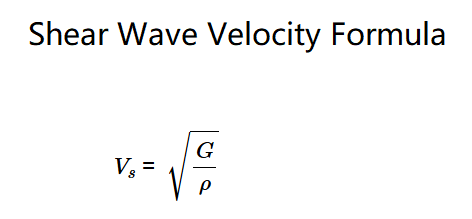 Home
Home
 Back
Back

Definition: This calculator computes the shear wave velocity (\(V_s\)), the speed of transverse waves in a medium, using shear modulus and density.
Purpose: It is used in geophysics, engineering, and seismology to analyze material properties, such as soil stability or seismic wave behavior.
The calculator uses this formula:
Explanation: Input shear modulus and density in your chosen units. The calculator converts inputs to base units (Pa, kg/m³) and outputs velocity in m/s, km/s, ft/s, mph, and Hz.
Unit Conversions:
Details: Shear wave velocity is vital for understanding material rigidity and seismic response. Examples include:
Applications: It supports foundation design, seismic risk analysis, and material testing.
Tips: Enter positive values with up to 4 decimal places and select units. Results are in m/s, km/s, ft/s, mph, and Hz. Values < 0.0001 use scientific notation. Avoid zero density.
Example: For \(G = 45 \, \text{GPa} = 45 \times 10^9 \, \text{Pa}\), \(\rho = 8940 \, \text{kg/m³} (copper)\):
Longitudinal Waves: Travel faster than shear waves, with speed \(V_L = \sqrt{\frac{E}{\rho}}\), where \(E\) is the elastic modulus.
Shear Modulus: Measures resistance to shear deformation, linked to elasticity via Poisson’s ratio.
Seismic Waves: Shear waves (S-waves) are slower than P-waves but critical for ground motion analysis.
Q: What’s the difference between m/s, km/s, ft/s, mph, and Hz?
A: m/s, km/s, ft/s, and mph are speed units; Hz is frequency (\(f = V_s / 2\pi\)) assuming a wavelength context.
Q: Can shear modulus be negative?
A: No, it’s a positive measure of rigidity.
Q: Why does the result show zero?
A: If density is zero, division by zero occurs, so results default to zero.
Q: Why are some results in scientific notation?
A: Values < 0.0001 are displayed as, e.g., \(1.23 \times 10^{-5}\), for clarity.
Q: How do I convert units manually?
A: Use the listed conversions (e.g., 1 GPa = \(10^9\) Pa) before inputting if needed.